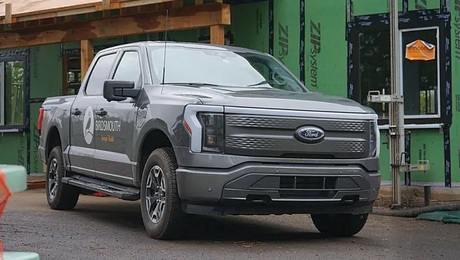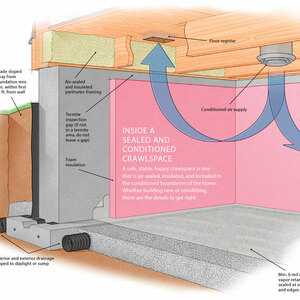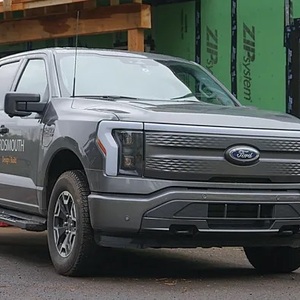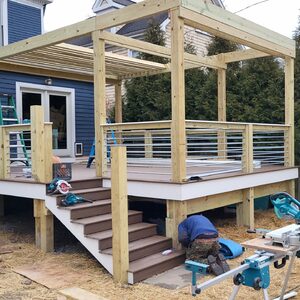*
I am trying to find information on purchasing Safetylines or Harness for Roofers. Also any help on what might be the best setup for roofing?
Discussion Forum
Discussion Forum
Up Next
Video Shorts
Featured Story

Ford Motor Company slashes prices for some F-150 Lightning models to stimulate demand for electric vehicles (EVs).
Highlights
"I have learned so much thanks to the searchable articles on the FHB website. I can confidently say that I expect to be a life-long subscriber." - M.K.

















Replies
*
Wayne,
Check with any major safety supply store in your area, I can not make any suggestions I do not know were you are. As for the best set-up a full body harness with a mechanical rope grab attacted to a well anchored lifeline, anchor the lifeline to quick mount bracket.
Check with your local construction association and safety agencies for any courses that they may offer on fall protection, many courses are offered free of charge to members and non-members. Please do not use any equipment before you understand how to use it correctly.
Good luck
*OSHA
*Having had one save my butt once, I'd recommend you check out the current OSHA recs, and then look at some of the kits from a supplier such as ABC Supply (which has a website and stores in about a zillion cities). I bought a Miller "kit", which included the harness, stopper, rope, a dozen anchors, and a nifty little bag from them for about $325. After being rescued by the fire department, I had to replace the stopper, but the kit has really worked out well; I use it on all roofs over 14/12.
*Lynn Ladder & Scaffold of West Lynn, MA has a extensive supply of fall protection gear for most any purpose. Check out http://www.lynnladder.com for info, plus you can order a catalog...HTH; -TJ
*I applaud your decision to get and use the safety gear. Any fall arrest gear made for the purpose is better than none. There are two types of gear that I know of, one is the OSHA safety stuff, the other is rock climbing gear. I know my climbing gear inside and out, I've done it for twenty years, and I don't really know OSHA equipment. Yes, in twenty years of climbing, my gear has kept me from hitting the ground more than once. It has also come in handy on roof jobs. The guts of it all is a combination of harness and line. Rock climbing harnesses tie in at the front (Fall off a roof and you'll be facing the rope)where OSHA harnesses tie in at the back (Fall off the roof and you'll be facing everything but the rope). What you'd like to be facing after you fall is up to you- climbers have a very distinct set of reasons for tieing in a the front. To my knowledge the differences are that rock climbing gear absorbs shock (rock climbing lead ropes stretch under load) where OSHA gear does not (or did not, that may have changed). The reason you'd want shock absorption capacity is to avoid the "crack-the-whip" effect of 'static line' (aka a rope that doesn't absorb some of the force of the fall). Given computer-controlled stitching, and the huge growth of indoor climbing, rock-climbing harness prices have dropped drastically in the past few years. You can find a decent harness these days for $50 or less, a spool end from one of manufacturers is at most $1 per foot, and maybe $30 for one of the hinge type plates with a clip-in ring. If you're on a budget and don't mind some leg work, I think you can put the whole rig together for $150. Remember that it's got to be comfortable and easy to use or you won't. I suggest you bring your tool belt with you, find both kinds of gear, try them on, walk around, jump up and down, and see what you think. If at all possible, hang from something ,in the harness, with your tool belt on. That should give you some sense of what you'd have to deal with once you'd come to a halt. My lord, scary stuff. But, as one friend said, "Cheap life insurance". If you want, email me at [email protected], tell me what town you live in, and I'll try to find a competent local climber who can actually, hands-on, show you what to do. Gerard
*Kernmantel rope has two bad characteristics: 1) It ages quickly (a year equals a fall and you take all these mini-falls on the last 20' of the pointy end; you've only got a six-fall, maybe a ten-fall rope to start with); it sucks in abrasive particles, which, because of the elasticity, abraid the core strands quickly; and, it wears the cover very quickly by being dragged over the abrasive shingles. 2) Because of the elasticity, if you had a long run to the anchor point and a little slack, and, took a fall from a second story, that rope could stretch enough to let you the ground. Of course, a roofer only falls maybe 10 feet at most before the rope arrests him; that's a lot different than a zipper from 100' above your belay and a static line won't provide a crippling jolt from 10 feet. Anyways, the OSHA stuff is in the realm of idiot proof so long as you attach both ends - full-blown climbing gear takes training and constant attention.
*
I am trying to find information on purchasing Safetylines or Harness for Roofers. Also any help on what might be the best setup for roofing?